No products in the cart.
NEWS
Creative Vegetable Trellis Ideas for Thriving Vertical Gardens
As gardening spaces become more precious, especially in urban environments, leveraging vertical space offers an incredible solution for growing a bountiful harvest. Implementing a trellis system is key to successful vertical gardening, providing essential support for climbing plants and maximizing your yield within a compact footprint. Beyond just practical support, the right trellis can transform your garden into a more attractive and structured space.
At Biogarden.asia, we understand the science behind healthy plant growth and the importance of utilizing every available resource. Training vining crops like tomatoes, beans, peas, cucumbers, and various squashes to grow upwards offers numerous benefits. It dramatically improves airflow around the plants, which is crucial for preventing fungal diseases. Keeping foliage and fruit off the ground also significantly reduces pest pressure and makes tending and harvesting much easier. Many gardeners find that plants supported by a trellis are more productive, putting more energy into developing fruit rather than sprawling across the soil.
Choosing the best vegetable trellis design depends on the specific plants you’re growing, your available space, aesthetic preferences, and budget. Trellis solutions can range from simple, cost-effective DIY structures using readily available materials to more permanent, architectural features that enhance your garden’s design. Whether you’re just starting out or looking to optimize your existing vertical setup, exploring different trellis options can help you find the perfect fit for your edible garden.
Let’s explore some practical and creative vegetable trellis ideas that can help you make the most of your growing space and enjoy a thriving vertical garden.
Why Go Vertical? The Benefits of Trellising
Utilizing vertical space with trellises is more than just a space-saving trick; it’s a strategy for healthier, more productive plants. When plants climb, their leaves get better sun exposure and air circulation, leading to stronger growth and reduced risk of common issues like powdery mildew. Pests that reside in the soil or low foliage have a harder time reaching the main plant structure and developing fruits. Harvesting is also a breeze – no more bending over to find hidden produce! Plus, vertically grown crops often produce cleaner, blemish-free fruit because they are off the damp ground. This approach aligns perfectly with sustainable gardening practices, promoting plant vitality naturally.
Creative Trellis Ideas for Your Edible Garden
There’s a trellis solution for almost every vining plant and every garden style. From simple DIY setups to more integrated designs, finding the right support structure is key to maximizing your vertical growing efforts.
Easy DIY Trellis Solutions
These options are often quick to build, cost-effective, and adaptable to various needs and spaces.
A-Frame Trellis
A straightforward A-frame trellis is a highly efficient structure for supporting a variety of climbing vegetables. It’s particularly well-suited for crops like pole beans, providing a stable framework for their vigorous growth. When constructed using materials such as canes or sticks, this design offers excellent flexibility and can be easily adjusted in length to accommodate different row sizes and plant spacing requirements.
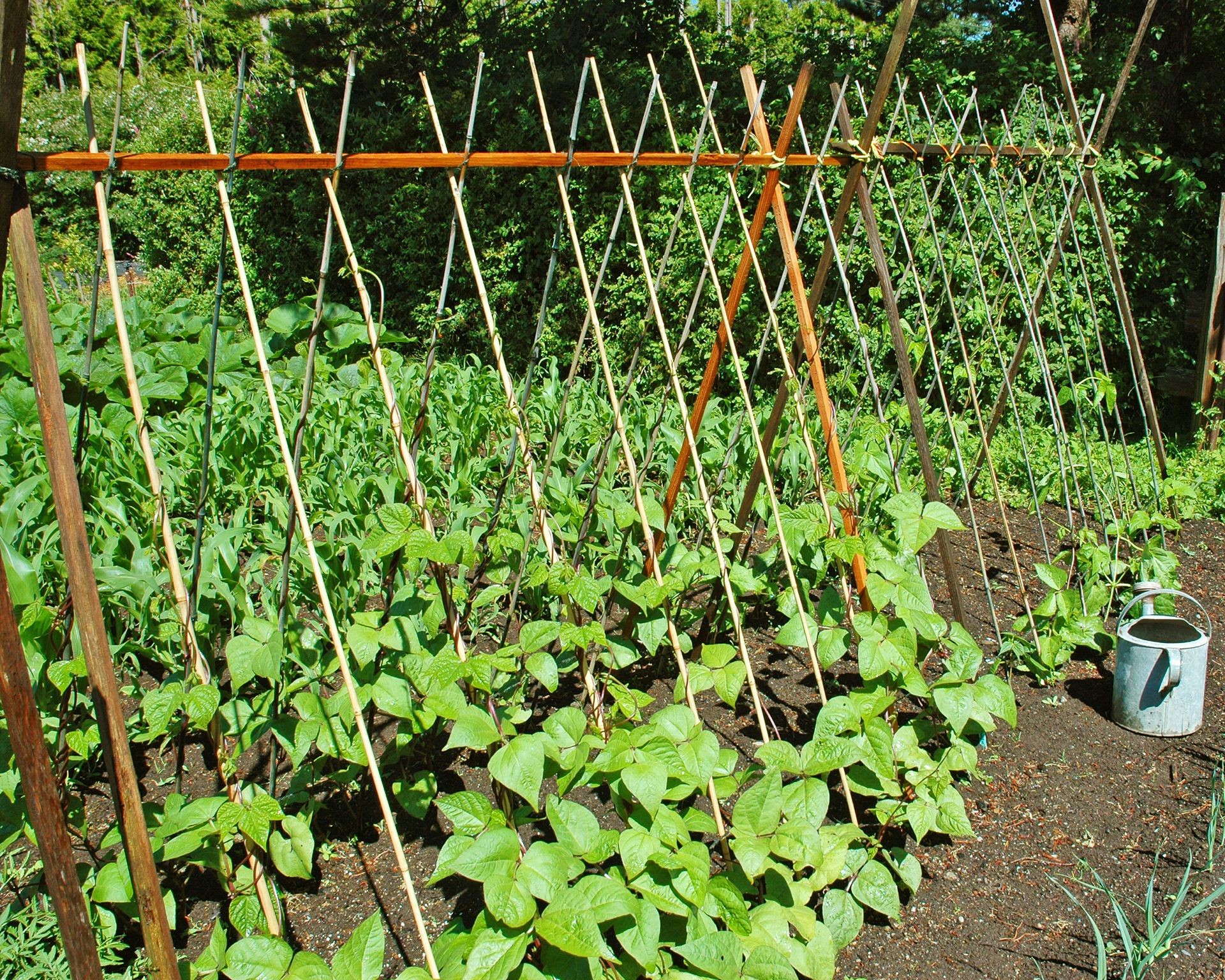 A simple A-frame trellis made from bamboo canes supporting climbing plants in a garden bed.
A simple A-frame trellis made from bamboo canes supporting climbing plants in a garden bed.
To construct an A-frame trellis, you’ll need thicker posts or sturdy timber for the end supports and slimmer canes or sticks (like bamboo) for the individual uprights. Begin by inserting the two end posts securely into the ground, crossing them at the top and tying them firmly together with strong twine or rope. Next, attach a horizontal bar or sturdy cane along the top between the two crossed supports. Finally, insert the slimmer canes along the row at the desired plant spacing, crossing them underneath the horizontal bar and securing them with string to form the A-frame shape. Ensure the base of each cane is also pushed into the soil for added stability.
Teepee Trellis
The teepee trellis is one of the simplest and most charming vertical supports you can build. Its ease of construction and versatility make it suitable for almost any vining crop, although it’s a traditional favorite for peas and beans. Plants are typically positioned in a circle around the base of the teepee, and their natural tendrils will readily climb the uprights.
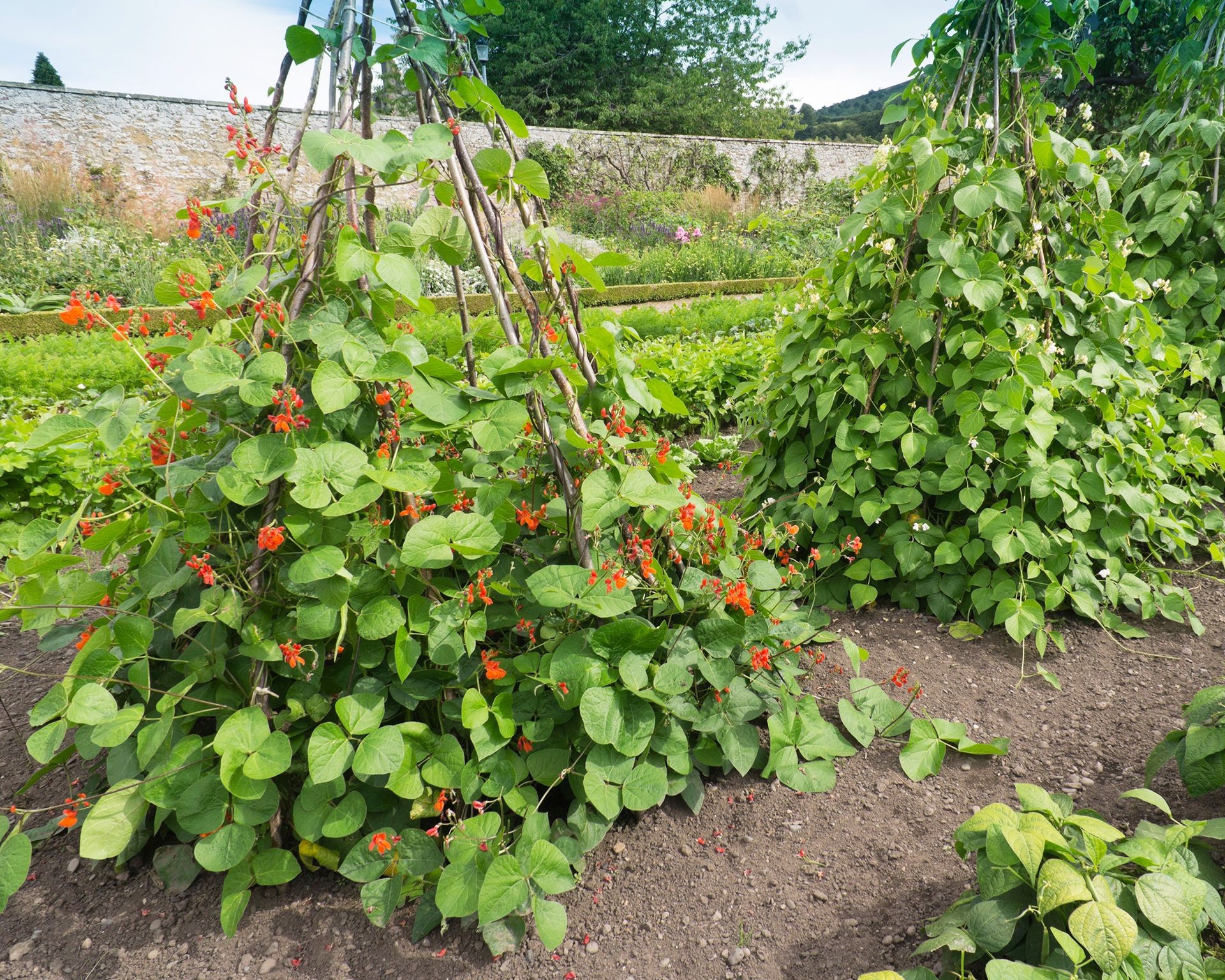 A rustic teepee-style trellis constructed from wooden stakes, ideal for peas and beans, in a sunny garden spot.
A rustic teepee-style trellis constructed from wooden stakes, ideal for peas and beans, in a sunny garden spot.
Creating a teepee is incredibly easy: simply push several sticks or canes into the ground in a circular arrangement around where you plan to plant. Gather the tops of the sticks together in the center and tie them securely with string or twine. For wider-spreading plants like squashes or cucumbers, you can tie additional strings horizontally around the teepee at intervals to give the vines more surfaces to grab onto. A narrower teepee design can even be adapted for tomato support.
Simple Stick Trellis
Embracing a rustic aesthetic, a simple trellis built from found sticks and branches is not only eco-friendly but also adds natural charm to your garden. While willow or bamboo canes also work well, utilizing pruned branches or sturdy sticks fits perfectly into a country garden style. This type of trellis is often best suited for supporting lower-growing or less vigorous climbing crops.
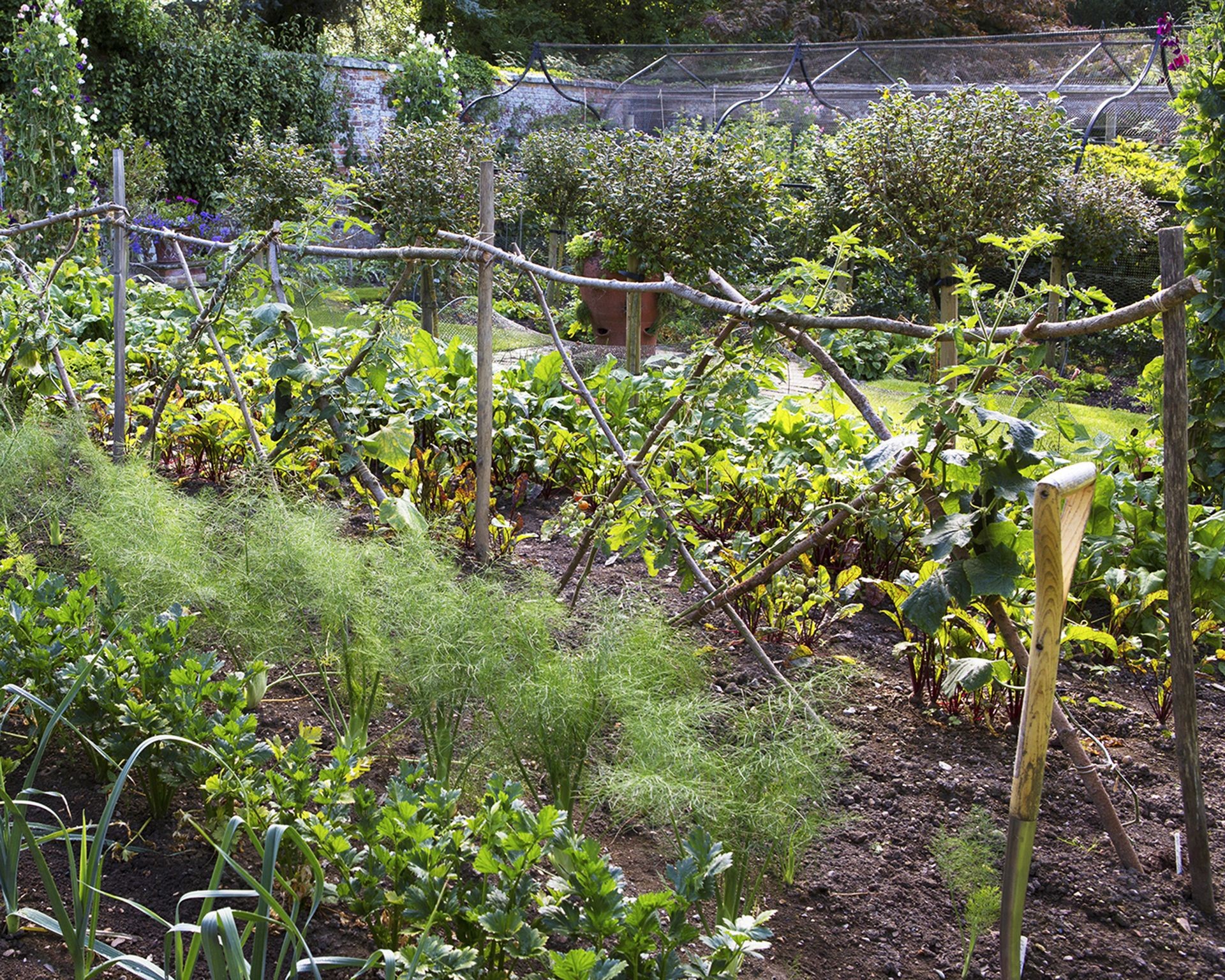 A rustic garden trellis built from natural sticks and branches arranged in a criss-cross pattern, supporting low-growing vines.
A rustic garden trellis built from natural sticks and branches arranged in a criss-cross pattern, supporting low-growing vines.
To create a criss-cross stick trellis, start by hammering in sturdier supporting posts or branches at intervals of roughly six feet, depending on the length of the horizontal branches you’ll use. Attach a horizontal branch or sturdy stick across the tops of these posts using twine. Then, arrange smaller sticks in an X-shape between the posts, securing them with twine where they intersect the horizontal support and pushing their bases firmly into the ground. This creates a charming, natural support structure.
String Support Systems
A string trellis offers a highly cost-effective and space-efficient method for training many vining crops. It’s widely used for supporting plants like tomatoes, beans, and peas, allowing them to grow tall and orderly. This method requires an overhead support structure from which to hang the strings.
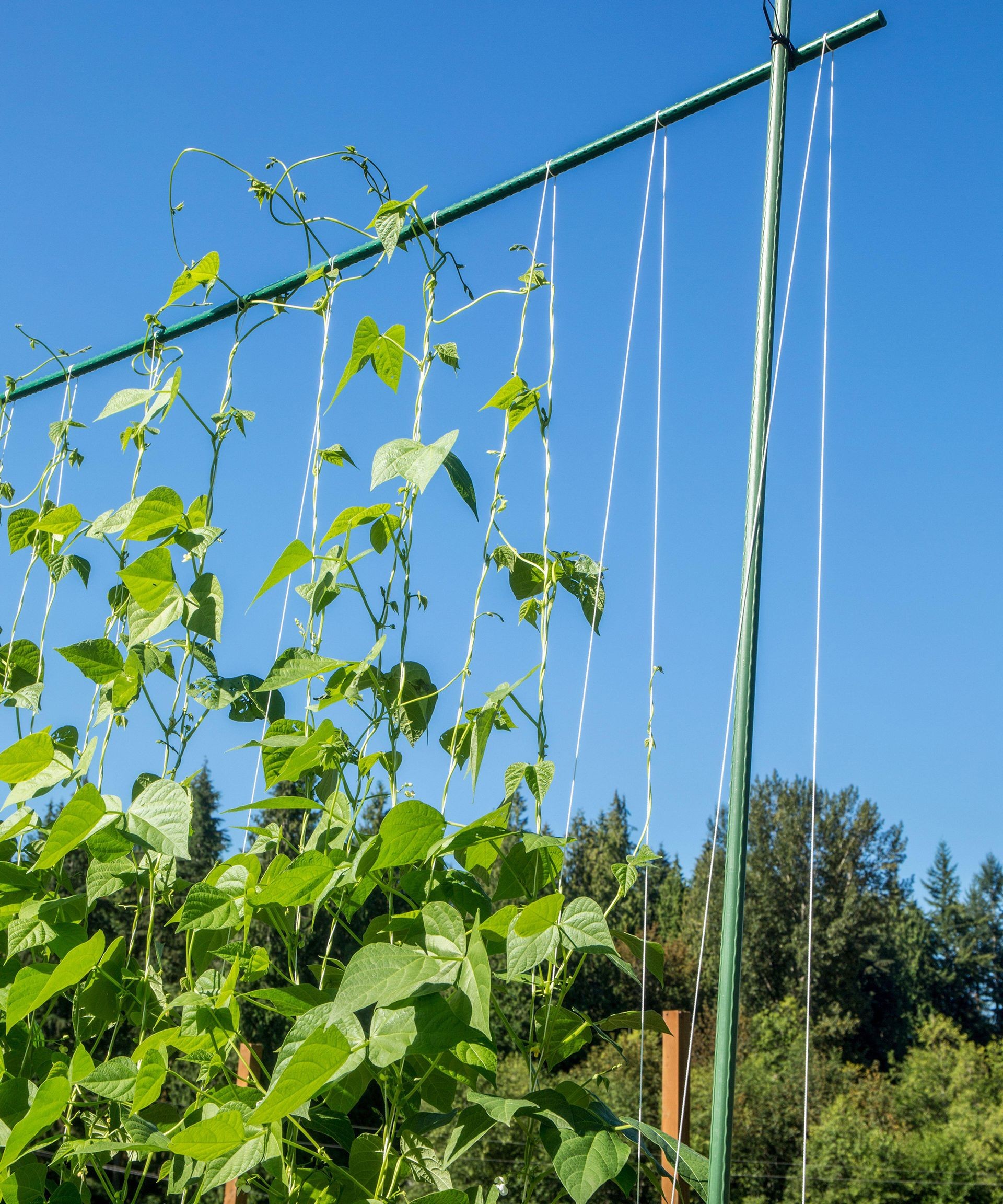 Dense growth of vining plants supported by a simple string trellis system in a garden.
Dense growth of vining plants supported by a simple string trellis system in a garden.
You’ll need a sturdy frame, which can be constructed from metal rods or timber, or you can utilize an existing structure like a greenhouse frame or pergola. Tie a length of strong garden twine or string to the top support, ideally looping it securely over a bar. Then, anchor the other end of the string to the ground directly below the plant using a garden staple or tying it to a short stake. As the plant grows, you gently guide it to twist around the string, or you can loosely clip it for added support.
Netting and Mesh Trellises
Using netting or mesh is arguably one of the simplest and most adaptable vegetable trellis solutions available. It’s inexpensive, lightweight, and can be cut to virtually any size or shape needed to support a wide range of crops. Plants can easily latch onto the mesh as they grow, and you can weave stems and vines through the openings for extra stability.
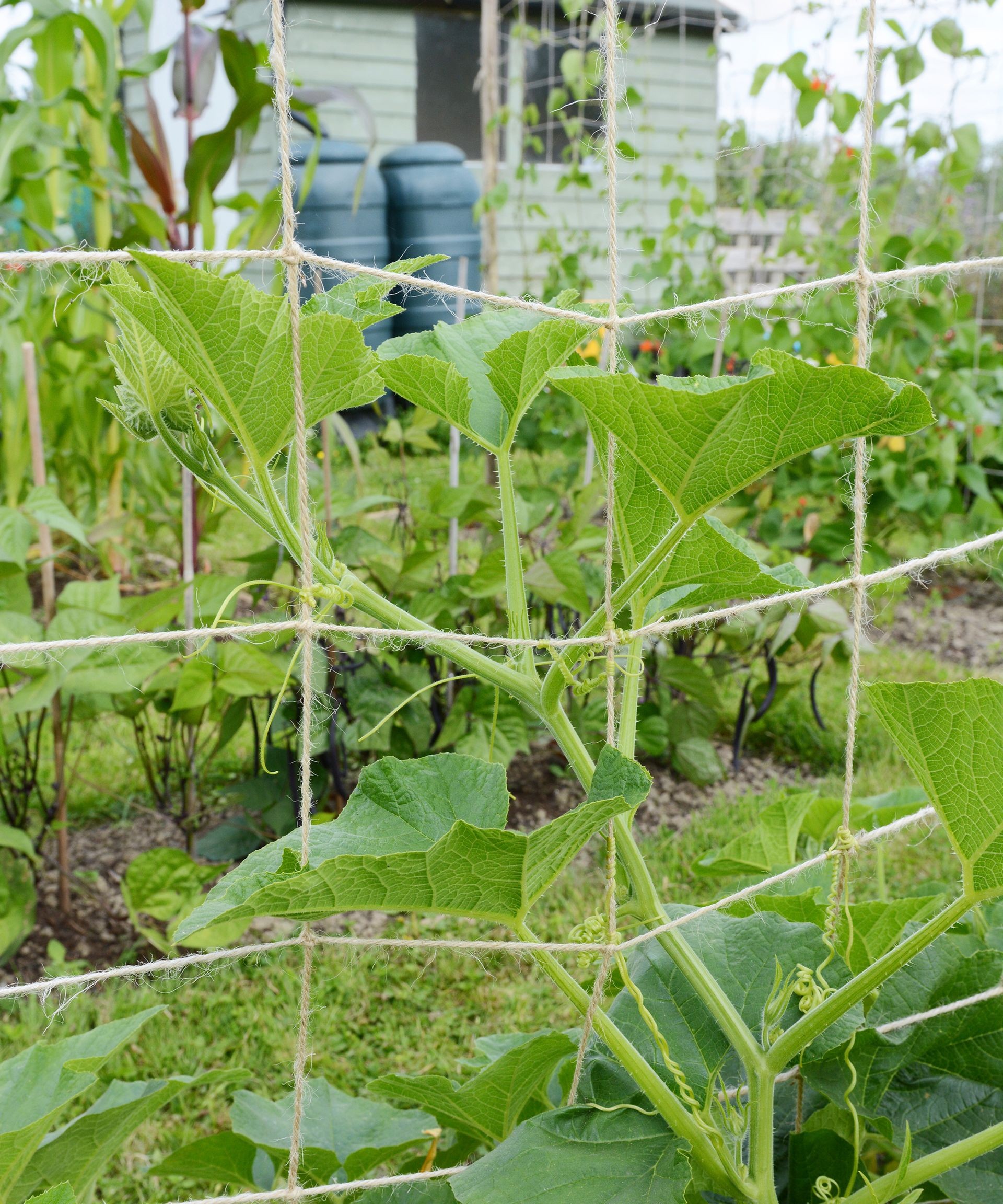 Vertical garden netting supporting rows of various climbing vegetables, demonstrating a cost-effective trellis solution.
Vertical garden netting supporting rows of various climbing vegetables, demonstrating a cost-effective trellis solution.
Like string trellises, netting requires a support structure to attach to. This could be canes, rods, wooden stakes, a pre-built frame, or even stapled directly onto a fence or wall. Ensure the netting is pulled taut to provide adequate support as the plants gain weight. Choose netting with mesh sizes appropriate for your crop; smaller openings are fine for peas and beans, while larger openings are better for tomatoes or cucumbers, allowing easier access for harvesting.
Trellis Solutions for Specific Needs & Spaces
These ideas incorporate trellising into popular gardening methods or are designed for specific types of plants or limited areas.
Trellis in Raised Beds
Growing vegetables in raised beds has gained immense popularity due to numerous benefits, including better soil control, improved drainage, and easier access. Integrating a trellis into your raised bed setup further enhances its versatility, allowing you to grow vining crops without needing an adjacent wall or fence.
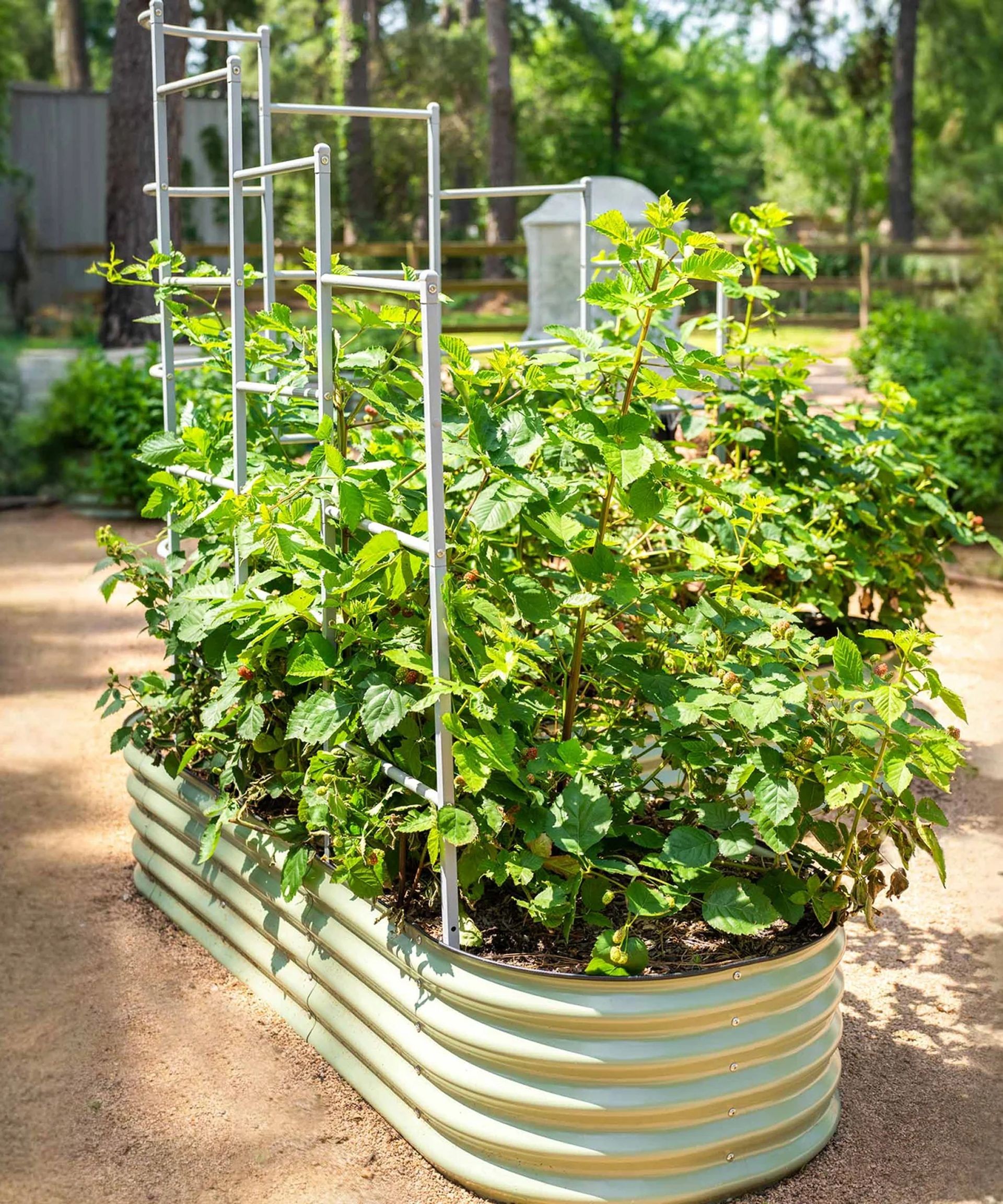 A metal raised garden bed featuring an integrated trellis wall, supporting lush green climbing vegetables.
A metal raised garden bed featuring an integrated trellis wall, supporting lush green climbing vegetables.
You can either custom-build a trellis structure directly attached to your raised bed frame or purchase ready-made trellis panels designed to fit common raised bed dimensions. Attaching the trellis to the bed provides stability and allows for flexible placement anywhere in your garden or patio. This integration creates a self-contained unit for your vertical garden.
Pots and Planters with Built-in Trellis
For gardeners with limited space, such as balconies, patios, or even indoor growing areas, a pot or planter equipped with a built-in trellis is an excellent solution. These containers offer portability and combine the growing medium and support structure in one unit.
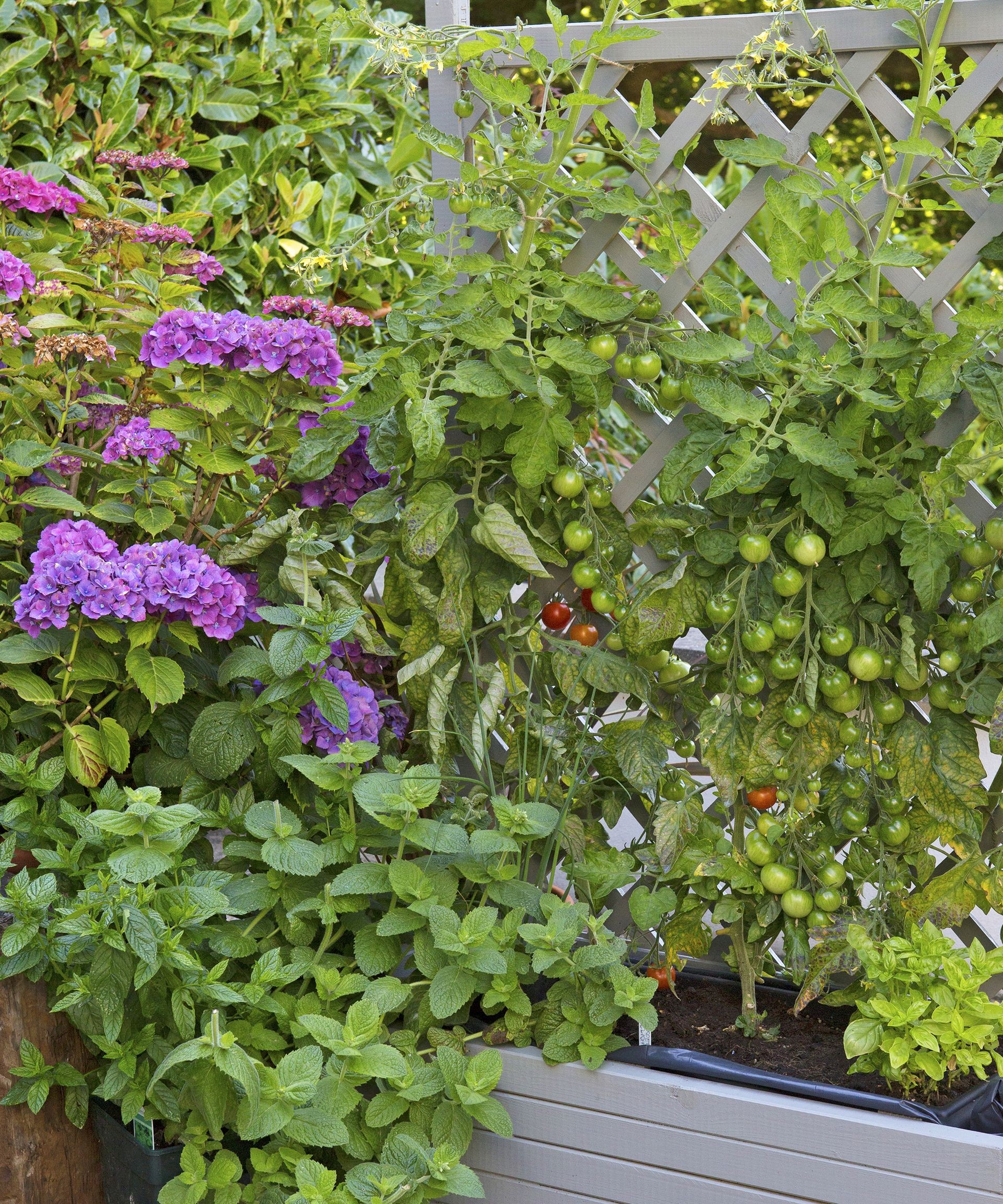 A portable planter pot with an integrated trellis panel, ideal for growing a tomato plant on a patio or small balcony.
A portable planter pot with an integrated trellis panel, ideal for growing a tomato plant on a patio or small balcony.
Available in various materials like metal, wood, or plastic, these units can support a single feature plant like a tomato or accommodate several smaller vining herbs or flowers. Depending on the size, you can experiment with different trailing plants. Consider adding companion plants like marigolds or nasturtiums directly in the planter to help deter common pests and add color.
Florida Weave for Tomatoes
The Florida weave is a simple and effective trellis method particularly favored for supporting determinate or semi-determinate tomato varieties in rows. It relies on rough wooden stakes and strong horizontal twine, woven back and forth between the stakes on either side of the tomato plants. Smooth stakes are not recommended as the twine tends to slip down.
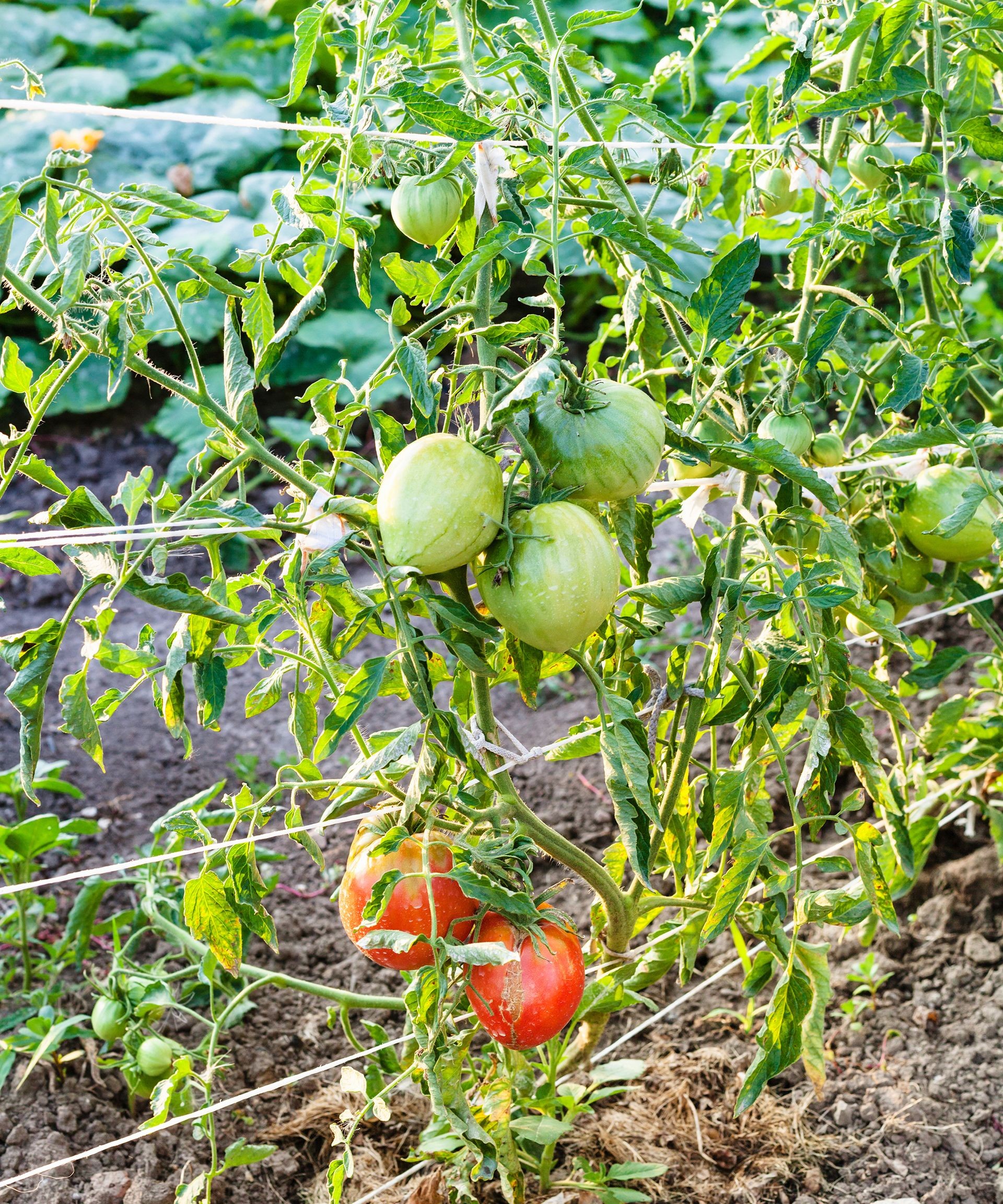 Tomato plants expertly trained using the Florida weave method, supported by stakes and horizontal twine.
Tomato plants expertly trained using the Florida weave method, supported by stakes and horizontal twine.
As the tomato plants grow taller, successive layers of twine are added, effectively weaving the plants into the support structure like a basket. This gentle confinement encourages the vines to grow upright while providing robust support for heavy fruit loads. Many growers using this method report larger, healthier fruit with fewer blemishes and easy access for pruning, inspecting, and harvesting.
Building a Tomato Cage
A tomato cage provides a sturdy, self-contained support structure specifically designed for the often heavy and sprawling growth habit of tomato plants, especially indeterminate varieties. While commercially available cages exist, building your own allows for customization and a stronger structure.
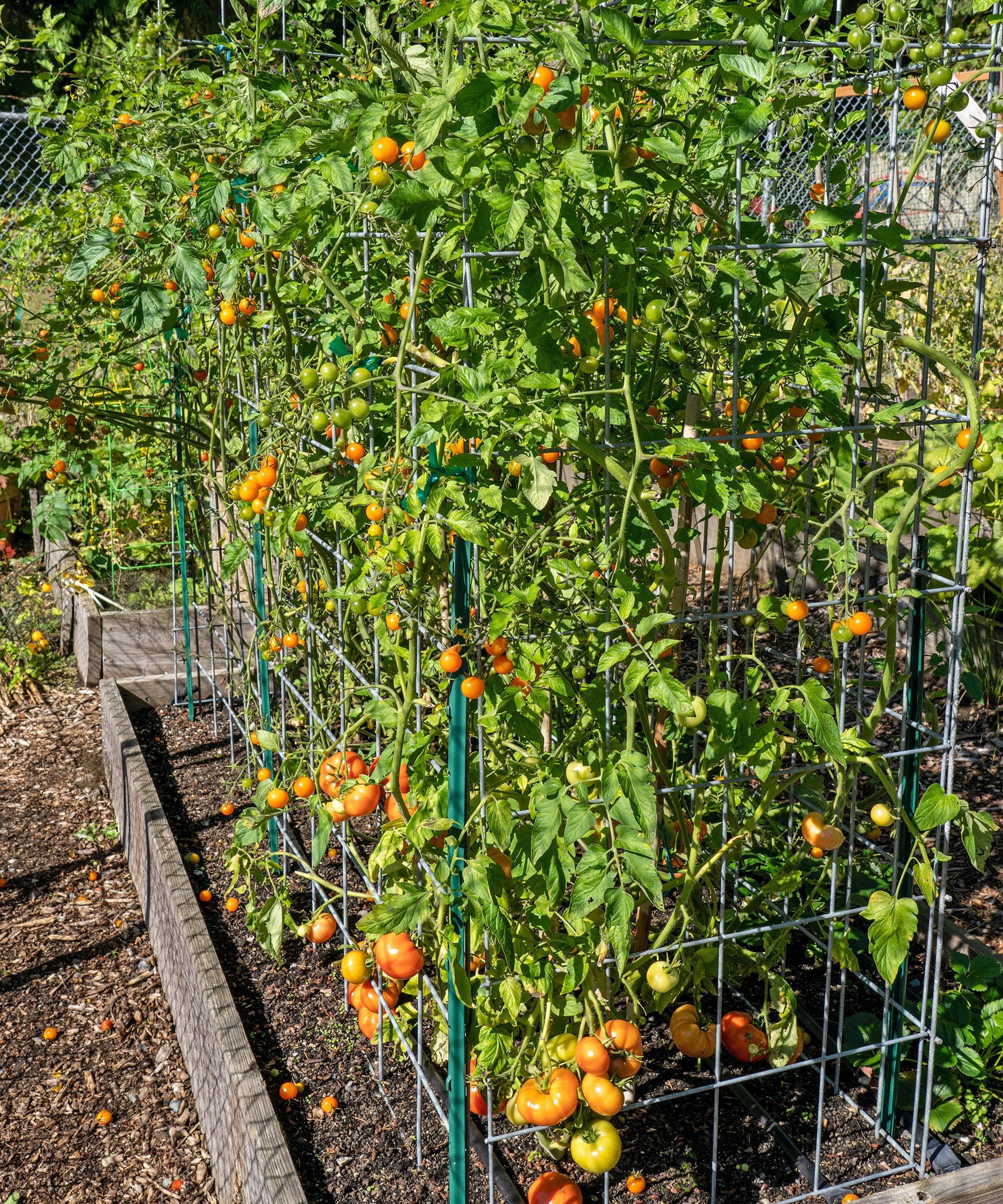 Sturdy wire mesh tomato cages supporting tomato plants heavy with fruit within raised garden beds.
Sturdy wire mesh tomato cages supporting tomato plants heavy with fruit within raised garden beds.
A common method uses a roll of heavy-gauge wire mesh fencing, often with 6-inch square openings to allow easy access for harvesting and pruning. Cut a length of the mesh and form it into a cylinder, securing the ends. Anchor the cage firmly in the ground using stakes. The large openings allow the tomato vines and fruits to be easily contained and supported within the cage structure without much need for additional tying. Avoid using chicken wire as the openings are typically too small.
Angled Trellises for Heavy Crops
For crops that produce heavy fruits like squashes, melons, or large cucumbers, a vertical trellis can sometimes lead to strain or fruit dropping. Positioning a trellis at an angle, typically around 45 degrees, offers an ideal solution. This allows the vines to spread out while keeping the developing fruits off the ground, reducing rot and pest damage.
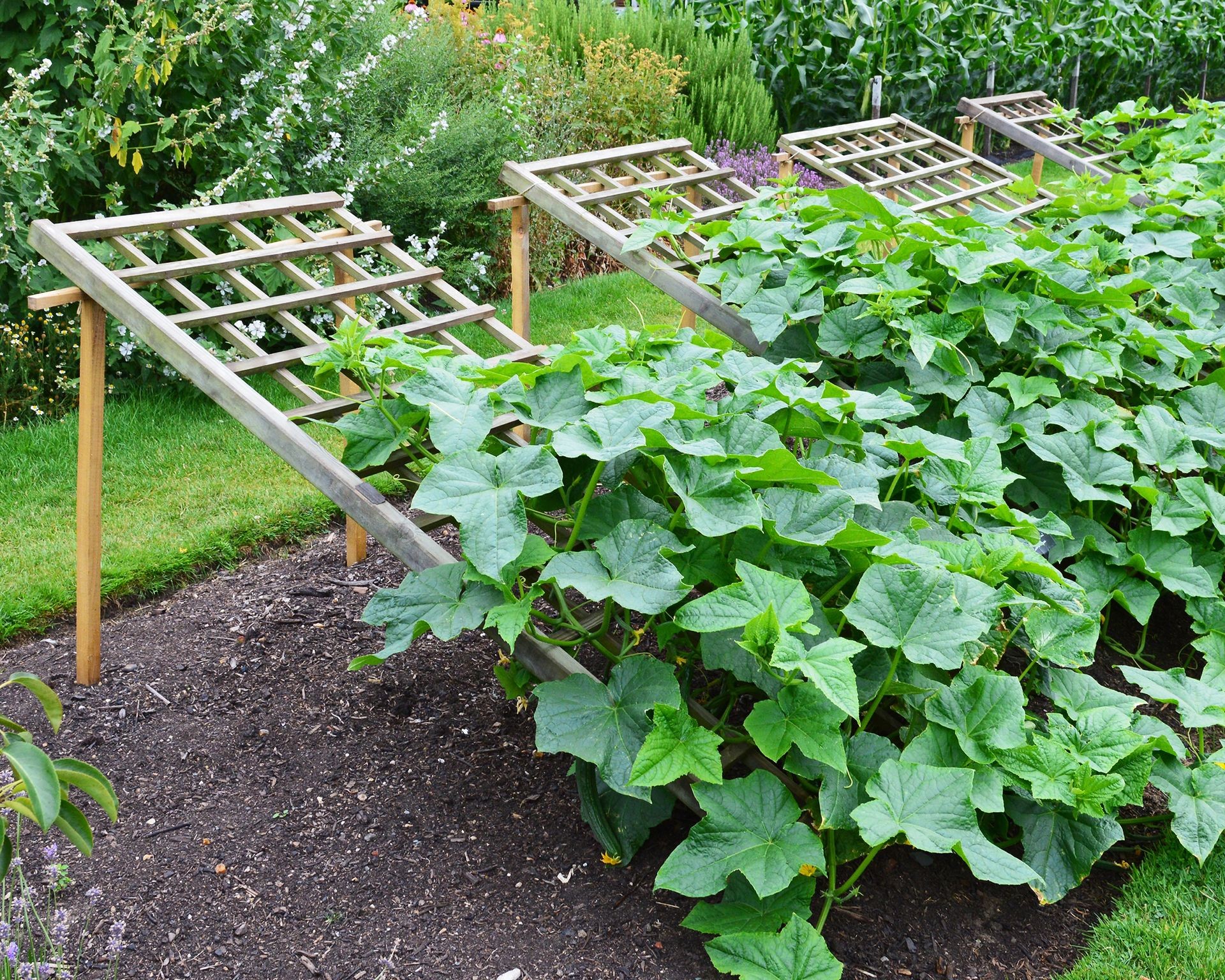 Cucumbers growing upwards on a trellis positioned at a 45-degree angle, suitable for supporting heavier fruiting vines.
Cucumbers growing upwards on a trellis positioned at a 45-degree angle, suitable for supporting heavier fruiting vines.
To create an angled trellis, construct a sturdy timber frame or use strong posts anchored securely in the ground as a support. Lean a wooden trellis panel against this support structure at the desired angle, securing it firmly with ties or bolts. The angled surface provides ample area for the vines to climb and spread, making harvesting and managing the plants much more convenient.
Architectural and Decorative Trellis Features
Beyond simple support, trellises can be integrated into the very design of your garden, creating stunning features that are both beautiful and productive.
Espaliering Fruit Trees
Espalier is an ancient horticultural technique that involves training the branches of trees or shrubs to grow flat against a wall, fence, or freestanding trellis structure. This method creates a striking visual feature and is an excellent way to grow fruit trees in limited spaces while improving fruit ripening due to increased sun exposure.
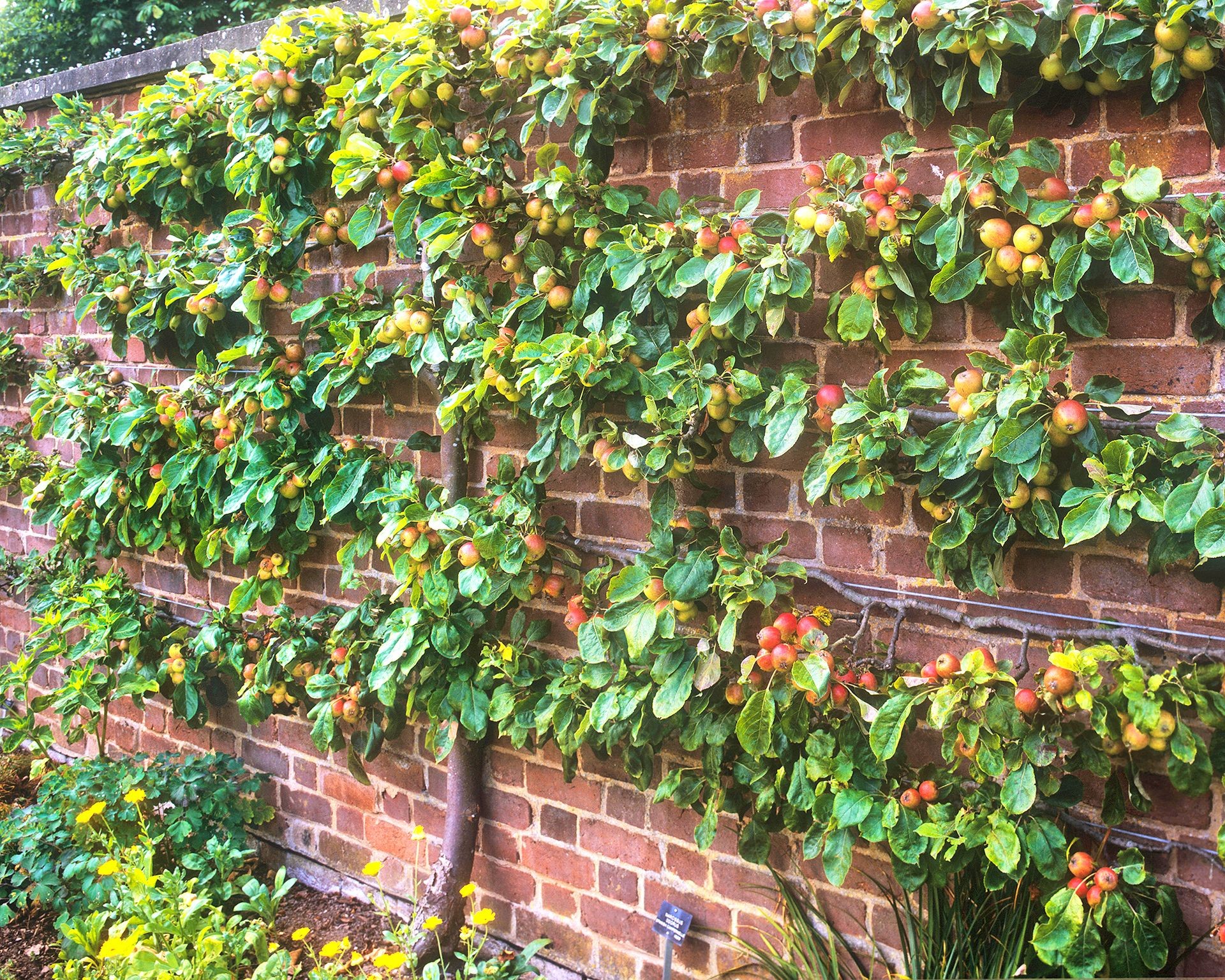 An apple tree branches beautifully espaliered flat against a brick wall using discreet wire supports.
An apple tree branches beautifully espaliered flat against a brick wall using discreet wire supports.
Apple and pear trees are classic choices for espalier, but plums and even some fig varieties can also be trained this way. A discreet support system using steel wires or wooden battens is typically installed against the surface. The key to successful espalier is starting with young, flexible trees and consistent pruning to maintain the desired shape as the branches grow along the wires or framework.
Arched Trellises for Walkways
An arched trellis serves as an elegant architectural element that can define a pathway or entrance within your garden while simultaneously acting as a support for climbing plants. Allowing vining crops to grow overhead creates a unique and immersive gardening experience, with fruits potentially hanging down for easy access.
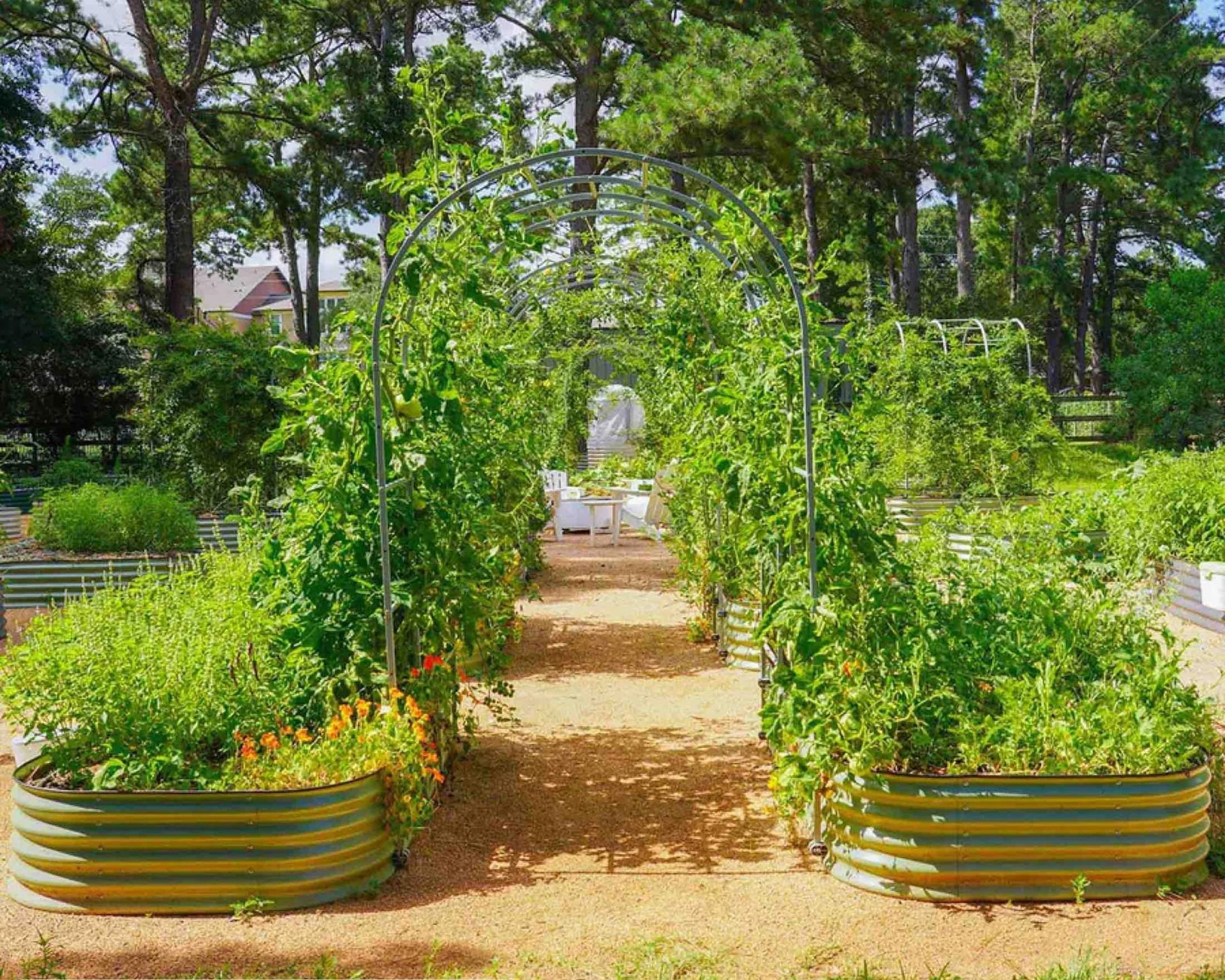 Metal raised garden beds complemented by an elegant arched trellis walkway, ideal for growing vining fruits or vegetables overhead.
Metal raised garden beds complemented by an elegant arched trellis walkway, ideal for growing vining fruits or vegetables overhead.
Arches are well-suited for fruiting vines like grapes, small apples, or pears, adding a touch of Mediterranean flair. They can also be used creatively for vegetables such as runner beans or cucumbers, turning common crops into a design feature. Sturdy arch structures, whether metal or wood, can be installed directly into the ground or paired beautifully with raised beds at either side of the walkway for an integrated look.
Using Pergolas for Edibles
Similar to arched trellises, pergolas provide a larger, more substantial overhead structure perfect for growing a significant amount of vining edibles. While often used to shade seating areas or define outdoor rooms, pergolas offer ample support for vigorous climbers, creating a beautiful canopy of foliage and fruit.
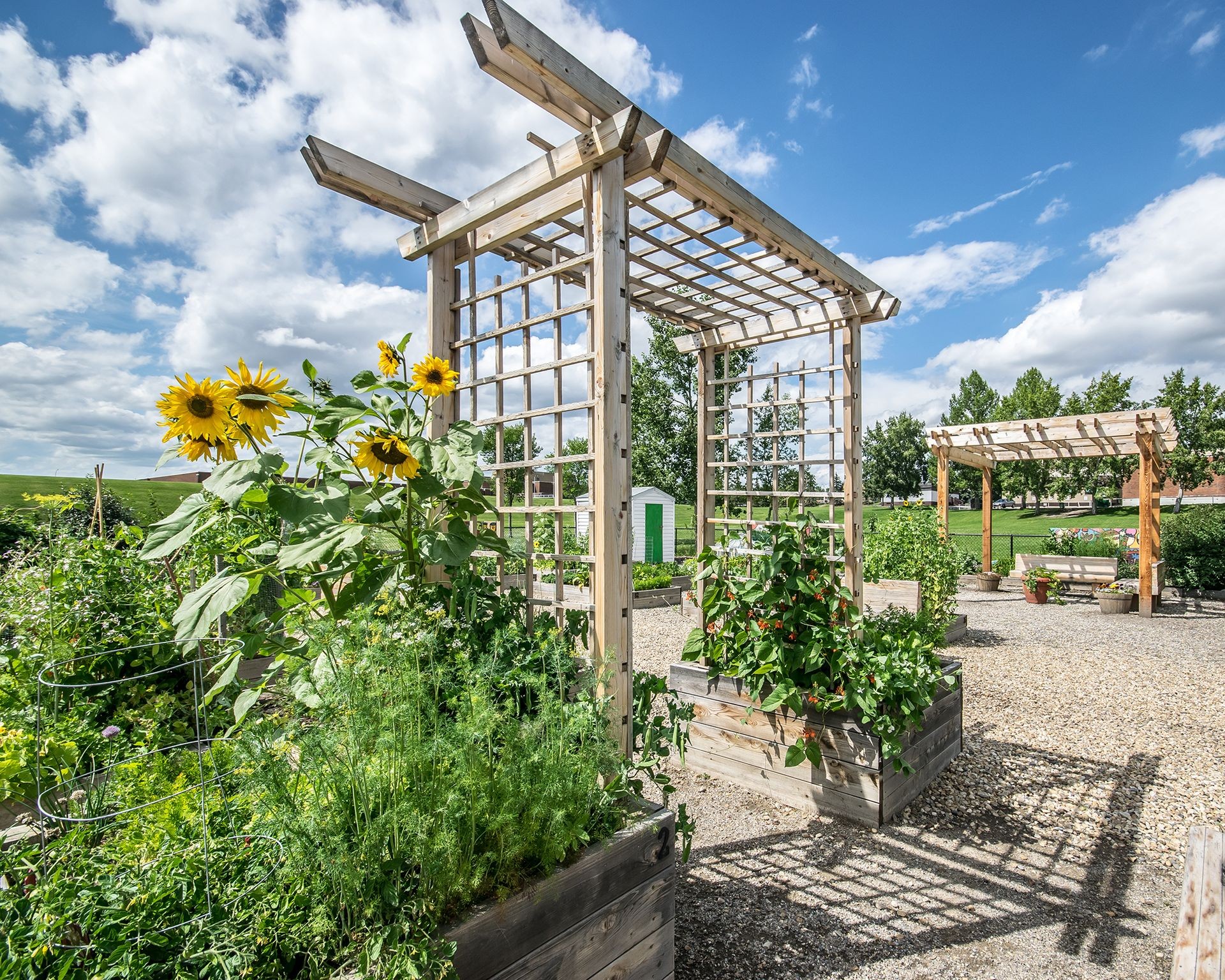 A wooden garden pergola covered in lush vining plants, showcasing its potential for growing edible crops like grapes or beans.
A wooden garden pergola covered in lush vining plants, showcasing its potential for growing edible crops like grapes or beans.
Grapevines are a traditional and effective choice for pergolas, but you can also grow ornamental vines alongside edible ones for added visual appeal. Vining vegetables like colorful squashes or scarlet runner beans also make charming additions, creating a productive and attractive overhead display.
Hanging Baskets on a Trellis Wall
Maximize vertical space by creating a multifunctional trellis wall that supports both climbing plants and hanging planters. Attaching small baskets or containers directly onto a sturdy trellis panel provides flexible planting opportunities, allowing you to grow quick-harvest crops in the upper sections while longer-season vines climb the main structure below.
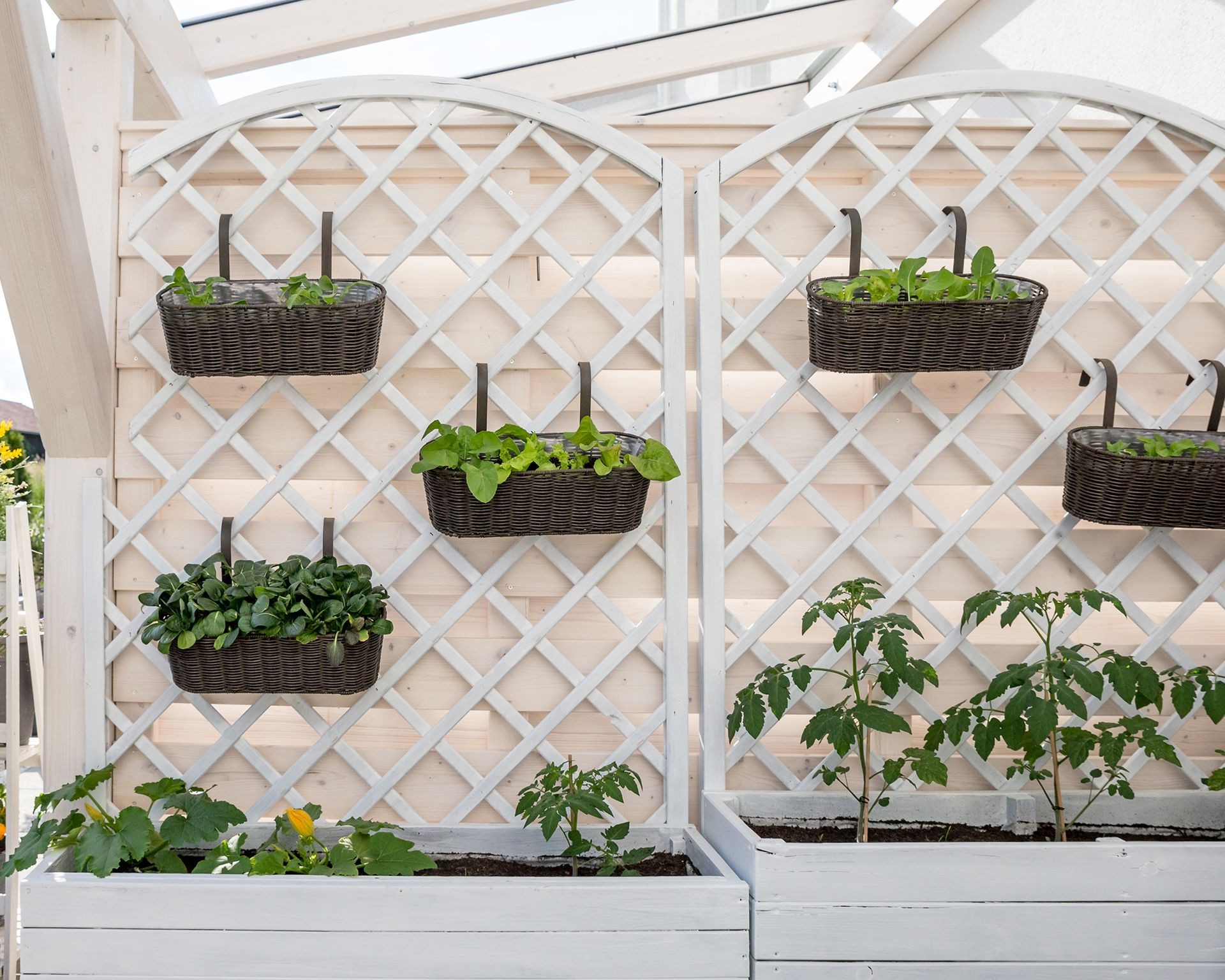 Mini planting baskets containing salad greens and herbs hung directly onto a garden trellis wall, utilizing vertical space.
Mini planting baskets containing salad greens and herbs hung directly onto a garden trellis wall, utilizing vertical space.
This method makes harvesting easy as you don’t need to bend down, and keeps low-growing greens like lettuce, radishes, and herbs safer from ground-level pests such as slugs and snails. Popular choices for wall-hung containers include various lettuces, radishes, basil, parsley, mint, and thyme. Many herbs grown this way also function as beneficial companion plants, helping to deter common garden pests like aphids.
Choosing the Right Trellis for Your Garden
Selecting the best trellis depends on a few key factors:
- Plant Type: Consider the plant’s growth habit (lightweight climber vs. heavy fruiter) and how it climbs (tendrils, twining stems, or needing ties).
- Space and Location: Match the trellis size and type to your available space, whether it’s a small balcony, a raised bed, or an open garden plot.
- Budget and Materials: Decide if you want a cost-effective DIY solution or are willing to invest in a more durable or decorative structure.
- Aesthetics: Choose a trellis design that complements your garden’s overall style.
No matter which type of trellis you choose, ensuring it is installed securely and can support the mature weight of your plants is crucial for success.
Implementing vertical gardening with trellises is a rewarding way to increase your harvest, improve plant health, and add structure and beauty to your garden space. With the variety of options available, from simple cane structures to elegant architectural features, there’s a perfect trellis idea waiting to transform your gardening experience.
We encourage you to try incorporating trellises into your edible garden this season. Explore the possibilities and enjoy the benefits of growing upwards! For all your gardening needs, from quality soil mixes to tools that help you set up your vertical supports, check out the solutions available at Biogarden.asia. Happy vertical gardening!



